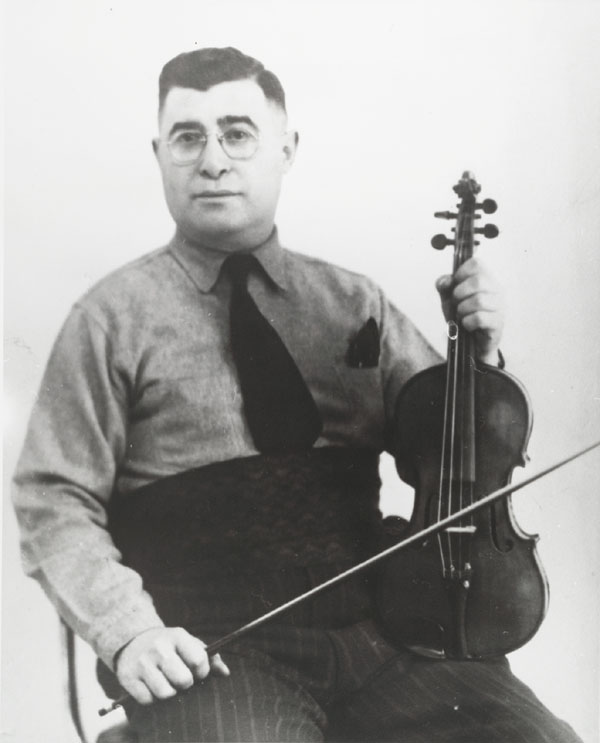 |
| Isidore Soucy - Image Courtesy of Collections Canada |
This blog is dedicated to the music and life of Erskine Morris, an old-time fiddler from Douglastown, Quebec. Through this blog myself and Erskine's son hope to document and promote the local fiddle traditions of the Gaspé Coast.
Erskine Morris (1913 – 1997)

Monday, October 31, 2011
Two Tunes From Isidore Soucy
Wednesday, October 19, 2011
The Little Boy's Reel
Listen to the Little Boy's Reel.
I really like the great syncopated rhythm Erskine gets on the low turn of this tune. Erskine was a master of rhythmic bow work. When you listen to his playing, its really clear that he is in full command of all the rhythmic expression required to bring fairly simple tunes to a higher level. Also, check out the really tight precision of his footwork which really kicks the tune into overdrive.
The fiddle is tuned with the bass string raised up to an A. This was the conventional tuning for the old Douglastown-area tunes in the key of D. It really makes the fiddle ring. Erskine is tuned a fair bit higher than concert pitch in this recording, about a whole semi-tone putting the tune actually around a concert Eb. In the era before the proliferation of electronic tuners, old-time fiddlers would often tune their fiddles to where they sounded approximately in tune with the standard A note (440 Hz) or where they had a "nice" ring to them. Sometimes, the fiddle just sings in a special way when tuned above or below the standard concert pitch. Here I feel the slightly higher pitch contributes to the excitement and energy of the tune.
This tune has all the hallmarks of a local Douglastown tune:
- Fiddle tuned with the bass string raised for the key of D
- Strong syncopated string crossings (low turn)
- Old-style melodic passages that don't quite conform to modern standard French Canadian reels (high turn)
- Repeated note "hooks" (high turn)
Enjoy
Thursday, October 13, 2011
From Laura Risk
Luc Chaput generously invited me to perform at both the 2010 and 2011 Douglastown Irish Weeks, and on both occasions I was really struck by the community’s love for fiddle music. I’ve played at lots of festivals but it’s not often that I have the feeling I had in Douglastown: that people are following every note and bowstroke. It’s the way fiddlers and dancers listen. And in fact, it wasn’t long before I realized that I was in a place where, until recently, that’s what entertainment meant: fiddling and dancing. No wonder I felt right at home!
I thought I’d start my contributions to this blog by posting a few video clips from a fantastic evening at the home of Phyllis Morris. This is the party that Glenn described in his Sept 2 post, so I won’t repeat all the details. I should say, though, that I hadn’t met Phyllis before this evening and I was really touched that she would welcome me so warmly into her home for this family party. We only had three fiddles between Glenn, myself, Joseph and Anthony Drody, and later Cecil Leggo, but that didn’t stop us from having a great party! We passed the fiddles around and with Brigid and Brian’s driving guitars and, at some moments, a whole row of foot tappers, the tunes seemed about ready to lift us out of our seats.
A huge thanks to Laura Holland, Phyllis’ daughter-in-law, who kindly offered to film the evening on my videocamera.
In this first clip of us playing “Joe Drody’s Jig”, you see Glenn passing his fiddle to Joseph Drody and then a nice close-up of Joseph and Anthony playing together. If you’re a fiddle player, you’ll probably notice that Joseph and Anthony are using slightly different bowing patterns, but both have a really driving rhythm to their playing.
Here’s a nice clip of Joseph playing “Peekaboo Waltz” – on my violin!
I thought I’d also include this clip of Glenn, Brigid and Brian playing “Tommy Rooney’s Jig”. Glenn has learned so many of the old tunes and really studied the old style – it’s fun to see him going full steam here!
One of the evening’s great surprises was getting to hear a few tunes from Cecil Leggo. I love the lift and swing that he puts into this version of “The Road to the Isles”:
That’s all for now. In the works: a post about Ernest Drody’s version of Eva’s tune. For the moment I’ll just say that if you’ve already learned the version that I played at Phyllis’ party (posted by Glenn on Sept 2), you will have a few bits to relearn...